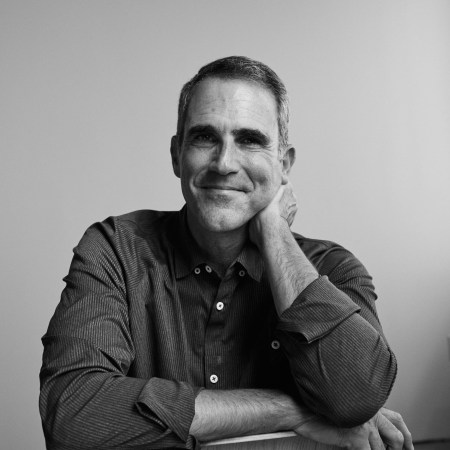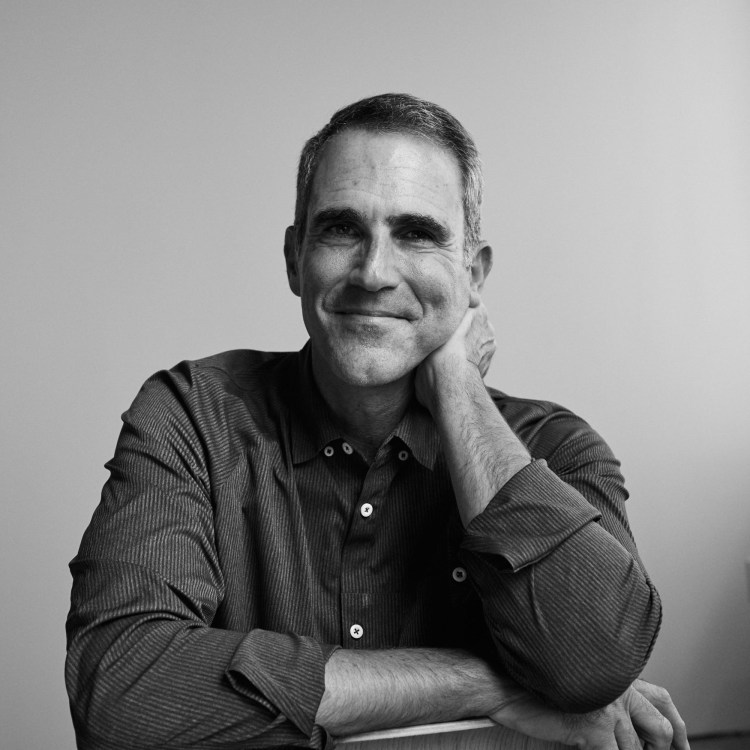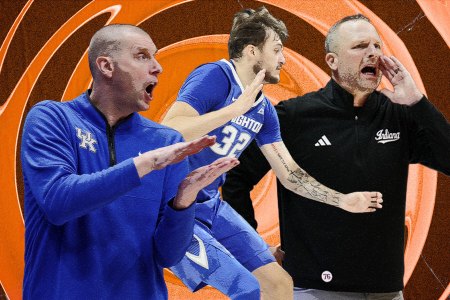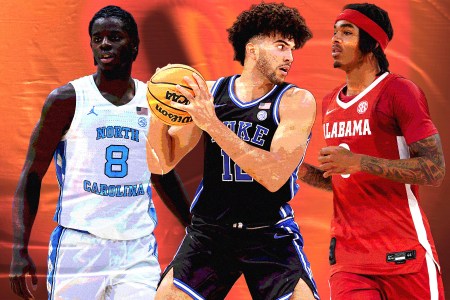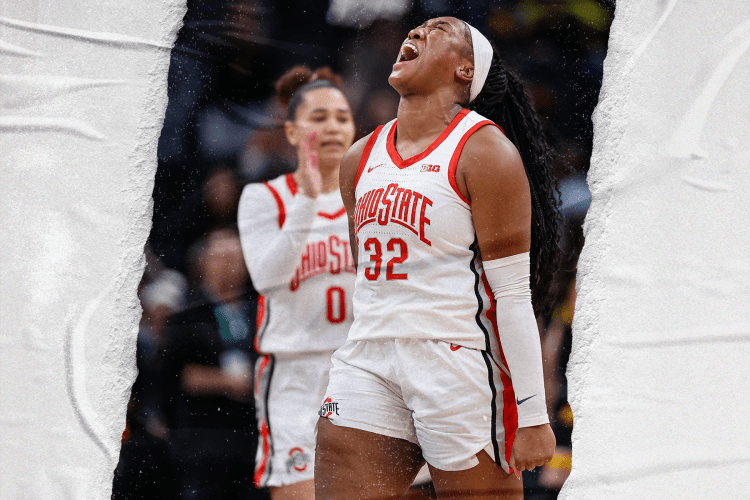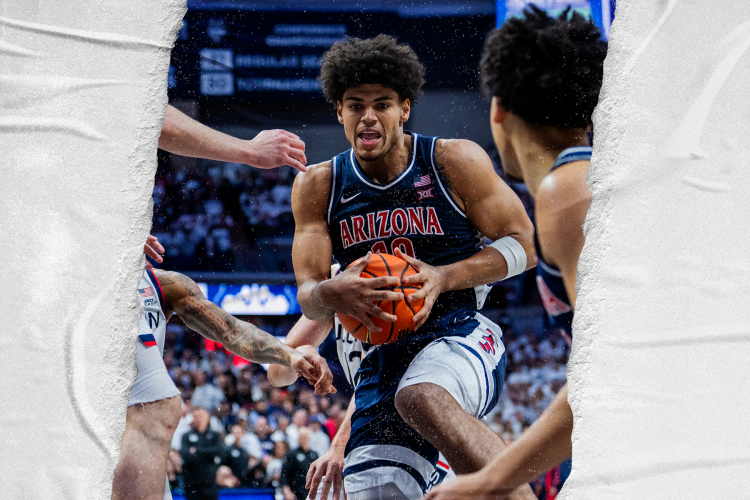Michigan’s season came to an end on Friday, March 28, in Atlanta, where the Wolverines lost 78-65 to Auburn in the Sweet Sixteen. The team wasn’t due to fly back to Ann Arbor until noon on Saturday, which meant Michigan coach Dusty May had the option of sleeping in. He declined that option. Instead, May hustled over to a local Starbucks for a 9 a.m. meeting with Elliot Cadeau, a 6-foot-1 sophomore point guard from North Carolina who had entered the transfer portal four days before.
Such is life for a college basketball coach in The Portal Era. “As soon as the season ended, we were recruiting immediately,” May tells Hoops HQ. The Starbucks Summit paid off on March 31, when Cadeau announced his commitment to Michigan. That is one of several wins May has enjoyed since the conclusion of his first season in Ann Arbor. It portends a lot more winning to come in year two.
Cadeau is part of a four-man transfer class which Hoops HQ correspondent Tristan Freeman ranks No. 2 nationally behind only Kentucky. Two other transfers will emigrate from power conference programs as well: Aday Mara, a 7-foot-3 junior center from UCLA, and Morez Johnson, a 6-foot-9 sophomore forward from Illinois. (Those class designations are for next season.) The fourth portal signee, Yaxel Lendeborg, a 6-foot-9 junior forward from UAB, could very well be the best of the quartet. He was named First Team All-AAC and AAC Defensive Player of the Year after averaging 17.7 points, 11.4 rebounds, 4.2 assists, 1.8 blocks and 1.7 steals while shooting 35.7 percent from three-point range. The Portal Report ranks Lendeborg as the nation’s No. 1 transfer.
It is not guaranteed that Lendeborg will play for Michigan. He has entered the NBA draft but retained his collegiate eligibility. Hoops HQ draft expert Jonathan Wasserman projects Lendeborg as a late first-round pick. That would allow him to make just over $2 million as dictated by the NBA’s rookie salary cap. Lendeborg could very well make more than that in Ann Arbor, although the earlier entry into the NBA would get his clock started towards a second contract, where the salaries are usually considerably greater.
The fact that Michigan has enough NIL resources to land such a quality class, much less compete with NBA Draft first-round money, speaks volumes about the war chest May has assembled. That, in turn, is a reflection of the confidence he earned from Michigan’s donor community last winter. May, who was previously the head coach at FAU for six years and led the Owls to the 2023 Final Four, brought in six transfers and four freshmen a year ago. The Wolverines were picked ninth in the Big Ten’s preseason poll, but they ended up finishing tied for second place during the regular season with a 14-6 record (27-10 overall), won the conference tournament and reached the Sweet Sixteen as a No. 5 seed.
Nothing succeeds like success, and as the wins piled up in January and February, the NIL dollars flowed accordingly. Though May would not divulge the specifics of his payroll, he is clearly as well-resourced as just about any coach in the country. “We’ve had a year of developing relationships and finding creative ways to generate money,” May says. “The winning helped tremendously. We’ve gotten people really excited. The market has changed a lot and our budget has changed as well. We’re obviously very competitive right now or we wouldn’t be here.”
Unlike many programs, Michigan does not appear to have a mega donor who can singlehandedly elevate the budget. Rather, the coffers have been filled through the efforts of Champions Circle, the NIL collective that supports all of Michigan athletics, as well as May himself. Asked how much time he spends on raising NIL money, May replies, “Probably more than recruiting.” That includes making himself available to attend fundraisers and mingling with donors, which not all head coaches are willing and eager to do.
“People giving at the level that it takes to be successful, they want interaction with the head coach, and they should,” says assistant coach Kyle Church, who doubles as the program’s General Manager. “Nothing supports that fundraising effort more than early success on the floor. That’s why it was so important for us to hit the ground running. There was definitely a snowball effect.”
The healthy budget also allowed May to retain four key players: starters Roddy Gayle and Nimari Burnett, both 6-foot-4 senior guards, plus top reserves Will Tschetter, a 6-foot-8 senior, and 6-foot-2 sophomore guard L.J. Cason. May is also bringing in three freshmen. The best of the trio is Trey McKenney, a 6-foot-4 guard from Michigan who was named a McDonald’s and Jordan Brand All-American and scored 22 points for Team USA at the Nike Hoop Summit last week in Portland.
May’s recruiting efforts were critical because he had to replace his top three scorers: Senior forward Vlad Goldin, who exhausted his eligibility; 7-foot junior forward Danny Wolf, who is expected to declare for the NBA Draft; and 6-foot-2 junior guard Tre Donaldson, who is transferring to Miami. May says he will probably add another player or two to the roster, perhaps including a long-term developmental piece, but for the time being, he says, “we’re close to being done.”
Like every coach around the country, May uses a variety of tools, including analytics, to evaluate players in the portal. But just as he did last season, May and his staff focused on guys whom they had already watched extensively. Michigan faced Mara and Johnson in the Big Ten. Lendeborg played for two years against May’s former FAU team in the AAC. Michigan’s scrimmage last fall against North Carolina gave the staff an up-close look at Cadeau. “I don’t think there’s been a guy that we found out of the portal yet that we weren’t extremely familiar with,” May says. “It’s not as if we’re drawing names out of a hat. We don’t recruit very many guys we don’t have a lot of information on.”
May’s decision to bring in Cadeau hastened Donaldson’s decision to transfer. Cadeau’s outside shooting needs work (he made 28.1 percent from three during his two seasons in Chapel Hill), but he is a capable facilitator who should allow May’s ball-sharing offense to flow better than it would with a ball-dominant combo guard like Donaldson. “He’s a true pass-first point guard,” May says of Cadeau. “I love his ability to push the pace and get our tempo up.”
Mara was a heralded prospect from Spain when he signed with UCLA in the summer of 2022, but he only averaged 9.6 minutes as a freshman and started one game as a sophomore. He came on towards the end of the season and showed enough flashes of potential, including a 22-point, five-rebound, two-block masterpiece during a late January win over Wisconsin, to augur a brighter future in Ann Arbor. “He’s been extremely productive when he’s played,” May says. “They had a glut of big guys last year so he split minutes, but we thought he was incredibly skilled and intelligent.”
The Mara-Lendeborg combination will evoke obvious comparisons to the Goldin-Wolf tandem that propelled the Wolverines last season. There are differences in their respective physiques and skill sets, but the benefits of pairing versatile big men together will be evident. “We’re going to use Yax all over the court like we did with Danny,” May says. “We think he can handle the ball. We think he can pass it. He’s just a matchup nightmare. If he’s got a slow guy on him, drive it. If he’s got a smaller guy, post him up.”
Johnson, meanwhile, will give the Wolverines the blue collar toughness they need in the paint. He battled injuries as a freshman but averaged 7.0 points and 6.7 rebounds in 17.6 minutes while starting eight games for the Illini. “He played as hard as anyone in our league,” May says. “He’s an elite rebounder. He improves our athleticism. And we think he’ll be able to expand his game because he works.”
While many coaches talk about eschewing high school recruiting, May says he will continue to bring in freshmen, not only for their talents but also for their potential to give the program more stability. “We’ll always try to recruit freshmen because we definitely want some continuity in our program,” he says. “We’d like to have more retention than we did this year.”
As May looks at his calendar, he doesn’t see a whole lot of unclaimed days ahead. Between the Big Ten meetings in Los Angeles, the NBA Draft and G League Combines in Chicago, recruiting trips overseas, camps in Michigan, a two-day golf tournament and fundraiser, July recruiting, a wedding, plus various workouts and meetings with his own players in Ann Arbor, he won’t have a lot of down time before fall workouts begin. “There will be about a week in August where I think we could probably all unwind,” he says.
Indeed, the way things are going in college basketball these days, there is no off-season. May knows better than anyone how much work there is to be done, but if the last few weeks are any indication, the winning is just beginning.
